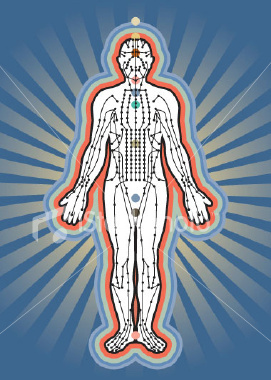If you are like most Americans, you have probably tried some form of complementary and alternative medicine (CAM), whether yoga, chiropractic, meditation, acupuncture, or a homeopathic treatment for the common cold. Consumers are very interested in the question of whether CAM works. Fewer consumers ask a second question: Why is CAM supposed to work? This second question is at least as important as the first, because asking it -- and insisting on getting more than superficial answers -- reveals that many forms of CAM are premised upon religious and spiritual assumptions about the nature of reality. These assumptions are not merely historical vestiges but deeply inform many current practices. As a result, becoming involved with CAM can affect not only one's health, but also one's religion.
Many of the most popular CAM remedies are closely tied to selective interpretations of religious traditions, such as Hinduism, Buddhism, Taoism (Daoism), and/or Western metaphysical spirituality. But CAM promotional materials may not use religious or spiritual language, but instead tout scientifically validated health benefits. Consumers who would hesitate to enter a Hindu or Buddhist temple might eagerly practice yoga or mindfulness meditation, if recommended by a physician.
It was not that long ago that most Americans rejected CAM as medical quackery or religious idolatry. Between the 1960s and 2000s, CAM moved from the fringes to the center of America's therapeutic culture. CAM is now mainstream: available for a fee not in temples, but in hospitals, public schools, YMCAs, Walmarts, corporate headquarters, and even Christian churches.
In 2007 , the most commonly used therapies in America were nonvitamin, nonmineral natural products (18 percent of Americans), deep breathing (13 percent), meditation (9 percent), chiropractic or osteopathic manipulation (9 percent), massage (8 percent), and yoga (6 percent). Smaller contingents used special diets (4 percent), homeopathy (2 percent), acupuncture (1 percent), t'ai chi or qigong (1 percent), energy healing or Reiki (.5 percent), naturopathy (0.3 percent), biofeedback (0.2 percent), or Ayurveda (0.1 percent). The popularity of some of the more marginal CAM therapies surged between 2002 and 2007: acupuncture, deep breathing, massage, meditation, naturopathy, and yoga. Notably, only a quarter of systematic medical reviews published in the intervening years concluded that any of these therapies work for the conditions for which they are used. In other words, CAM therapies did not grow in popularity because scientific evidence validated their efficacy.
One key to CAM's newfound popularity is that marketers have learned to advertise CAM as not religious, but as health care, fitness, scientific techniques (allegedly supported by quantum physics and neuroscience), or universal "spirituality" congruent with any or no specific religion.
Much of the attraction is that many Americans have unmet health needs, despite appealing for help to conventional medical doctors or traditional religious institutions. In America's postmodern culture, it has become commonplace -- despite the materialistic premises of modern medicine -- to speak of an interconnection among body/mind/spirit. CAM presumably heals body and mind by mobilizing more-than-physical, that is meta-physical, or spiritual energy.
 A central assumption across diverse CAM therapies is that there is universal life force or vital energy that flows through the cosmos and can be mobilized to heal the human body. This force goes by various names, such as qi, ki, prana, vital force, or Innate Intelligence (think of The Force in Star Wars). Healers envision the body as criss-crossed by energy channels (known as nadis or meridians, joined at chakras), and may seek to unblock the free flow of vital energy or rebalance opposing energy principles (yin and yang). Although the same word, energy, describes known forces such as electricity, vital energy is more than physical: alive and life-giving, intelligent, and creative. Conventional scientific equipment cannot confirm its existence. Instead, "evidence" comes from extra-sensory intuition, physical sensations such as warmth or tingling experienced during healing rituals, or relief of symptoms subsequent to energy treatments (even if conventional treatments were used simultaneously).
A central assumption across diverse CAM therapies is that there is universal life force or vital energy that flows through the cosmos and can be mobilized to heal the human body. This force goes by various names, such as qi, ki, prana, vital force, or Innate Intelligence (think of The Force in Star Wars). Healers envision the body as criss-crossed by energy channels (known as nadis or meridians, joined at chakras), and may seek to unblock the free flow of vital energy or rebalance opposing energy principles (yin and yang). Although the same word, energy, describes known forces such as electricity, vital energy is more than physical: alive and life-giving, intelligent, and creative. Conventional scientific equipment cannot confirm its existence. Instead, "evidence" comes from extra-sensory intuition, physical sensations such as warmth or tingling experienced during healing rituals, or relief of symptoms subsequent to energy treatments (even if conventional treatments were used simultaneously).
Many consumers experiment with CAM, not because they share such religious views, but because they hope CAM will work for them. If health improves, CAM is credited. Over time, consumers may gradually become more comfortable, and indeed interested in, the religious ideas that often accompany CAM procedures. Consumers may even come to adopt fundamentally different religious worldviews. Because of the processes by which this transition occurs (about which I will have more to say in subsequent posts) and imbalances in knowledge and power between CAM providers and clients, consumers may have difficulty making the health-care and religious decisions they would have wanted to make had they had more information earlier. In future posts, I'll talk more about what makes specific CAM therapies "religious," compare CAM with Christian worldviews, summarize scientific research on CAM, explain how CAM became mainstream, and consider the medical, ethical, religious, and legal implications.